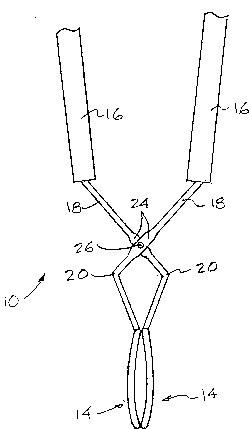Some of the information on this Web page has been provided by external sources. The Government of Canada is not responsible for the accuracy, reliability or currency of the information supplied by external sources. Users wishing to rely upon this information should consult directly with the source of the information. Content provided by external sources is not subject to official languages, privacy and accessibility requirements.
Any discrepancies in the text and image of the Claims and Abstract are due to differing posting times. Text of the Claims and Abstract are posted:
| (12) Patent Application: | (11) CA 2041999 |
|---|---|
| (54) English Title: | ANGLED TONGS |
| (54) French Title: | TENAILLES A POINTES EXCENTREES |
| Status: | Deemed Abandoned and Beyond the Period of Reinstatement - Pending Response to Notice of Disregarded Communication |
| (51) International Patent Classification (IPC): |
|
|---|---|
| (72) Inventors : |
|
| (73) Owners : |
|
| (71) Applicants : | |
| (74) Agent: | ADE & COMPANY |
| (74) Associate agent: | |
| (45) Issued: | |
| (22) Filed Date: | 1991-05-07 |
| (41) Open to Public Inspection: | 1992-11-08 |
| Availability of licence: | N/A |
| Dedicated to the Public: | N/A |
| (25) Language of filing: | English |
| Patent Cooperation Treaty (PCT): | No |
|---|
| (30) Application Priority Data: | None |
|---|
-7-
ANGLED TONGS
ABSTRACT OF THE DISCLOSURE
An apparatus is provided for grasping objects. It is
particularly useful for grasping objects on the ground with
the user in a standing position. The apparatus has
particular utility in picking up animal droppings. It
consists of two long arms with long, rigid handles and
shorter, resilient shanks that cross and are pivotally
connected to one another where they cross. Adjacent the
pivot, each shank carries an object grasping head. When the
heads are in engagement and the shanks are undeformed, the
handles diverge so that the handles can be brought together
provide considerable force for grasping a thin-walled object
such as a can, bag or the like. When the handles are brought
together, they may be held in place using a loop of thong on
one of the handles.
Note: Claims are shown in the official language in which they were submitted.
Note: Descriptions are shown in the official language in which they were submitted.

2024-08-01:As part of the Next Generation Patents (NGP) transition, the Canadian Patents Database (CPD) now contains a more detailed Event History, which replicates the Event Log of our new back-office solution.
Please note that "Inactive:" events refers to events no longer in use in our new back-office solution.
For a clearer understanding of the status of the application/patent presented on this page, the site Disclaimer , as well as the definitions for Patent , Event History , Maintenance Fee and Payment History should be consulted.
| Description | Date |
|---|---|
| Time Limit for Reversal Expired | 1998-05-07 |
| Application Not Reinstated by Deadline | 1998-05-07 |
| Deemed Abandoned - Failure to Respond to Maintenance Fee Notice | 1997-05-07 |
| Application Published (Open to Public Inspection) | 1992-11-08 |
| Abandonment Date | Reason | Reinstatement Date |
|---|---|---|
| 1997-05-07 |
Note: Records showing the ownership history in alphabetical order.
| Current Owners on Record |
|---|
| CAROL E. YOUMANS |
| Past Owners on Record |
|---|
| None |